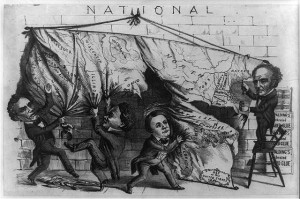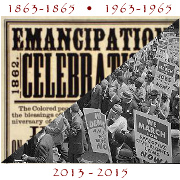Myth-busting and the Civil War: The South turns to federal authority to preserve slavery
Posted September 21st, 2012 by Katrina BrowneCategory: Public History Tags: Battle of Antietam, Battle of Sharpsburg, Drew Gilpin Faust, Dwight Pitcaithley, National Park Service, Southern secession

1860 political cartoon, showing presidential candidates Lincoln, Douglas, Breckinridge, and Bell dividing the country.
This is the second part of Katrina Browne’s reflections on the 150th anniversary commemoration at Antietam this past weekend. The first part, focused on northern myths about the civil war, was entitled “The Emancipation Proclamation: ‘… all the moral grandeur of a bill of lading.’“
Irony. It’s the word that came fast to mind as I sat listening this past weekend to former National Park Service Chief Historian Dwight Pitcaithley as he revealed the following: that in the heated days of late 1860 and early 1861, from just after Lincoln’s election to several weeks after his inauguration, pro-slavery Southern political leaders, while seceding, simultaneously turned to the power of the federal government to try to protect slavery! I was at the 150th anniversary commemoration of the Battle of Antietam/Sharpsburg, and Prof. Pitcaithley was speaking on “Secession as a Constitutional Crisis.”
He explained that in the span of five months, no fewer than 66 constitutional amendments were proposed in Congress to shore up the institution of slavery. To turn to the Constitution was the ultimate turn to federal power in an attempt to enshrine slavery. The case was made primarily based on the 5th amendment’s protection of the right to property. (Interestingly, pro-abolition crusaders were turning to the same clause in the 5th amendment: that no person “shall be deprived of life, liberty, or property, without due process of law” and focusing on liberty rather than property. Ironies abounding.)
I already knew that the argument that the South fought the Civil War to protect states’ rights, not slavery, was fundamentally flawed: the Declarations of Secession written by Southern states are full of language naming the issue of slavery as a cause of secession. But this new revelation drove the point strikingly home: the determination to protect slavery in the South was so strong, that Southern leaders were going to turn to whatever they could to effect that goal, including the power of the federal government! They would turn simultaneously to the states’ rights argument… whatever worked. The North would do the same: use whichever powers they could marshal to achieve their ends. Many abolitionists were using states’ rights arguments in the disputes about whether new territories would be slave or free.
So today, as hot debates occur around the Presidential election over healthcare, entitlements and various social programs administered by the federal government, advocates on either side often end up resorting to a states’ rights or federal powers line of argument. We might do well to notice that people now, as then, are often more interested in the specific outcomes they want, than the ideological merits of the means/authority to get there. Most people want the federal government to provide aid after natural disasters and keep air and water and food clean and healthy, while they might not want the government to handle other matters.
And another thought emerged as I wandered the fields at Antietam where so many young men perished, and as I watched Death and the Civil War on American Experience this week: that the men who fought and died for the Confederacy had their own reasons for fighting that sometimes merged with those of their political leaders, and sometimes didn’t, and were probably more nuanced than the “slavery rationale vs. states’ rights rationale” debate allows. They might have fought for both, for neither. States’ rights, in any case, undoubtedly existed as a more felt sentiment—to do with home, family, town, tradition—than as a legal concept. As a Northerner, it is lately dawning on me that in addition to the massive extent to which slavery was at the center of what was at stake, the culture war between white North and white South was also longstanding. As I probe more, I have come to learn that Northern arrogance and sense of superiority towards Southerners was a real thing, and would certainly account for part of the animus that was unleashed on both sides. And so we can ask too, 150 years later: where does that stand now? And how do our deflections onto each other keep both white Northerners (which today can mean all non-Southerners across the nation) and white Southerners from stepping up for racial equity?



Leave a Reply